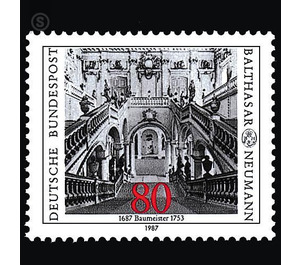300th birthday of Balthasar Neumann - Germany / Federal Republic of Germany 1987 - 80 Pfennig
Theme: Well-known people
| Country | Germany / Federal Republic of Germany |
| Issue Date | 1987 |
| Face Value | 80.00 |
| Color | black white |
| Perforation | K 14:13 3/4 |
| Printing Type | Photogravure 3-color |
| Stamp Type | Postage stamp |
| Item Type | Stamp |
| Chronological Issue Number | 1180 |
| Chronological Chapter | GER-BRD |
| SID | 566276 |
| In 42 Wishlists | |
Balthasar Neumann was born in Eger in the last days of January 1687. When the seventh of eight children of the cloth maker Christoph Neumann was baptized on January 30 this year in the Niklauskirche zu Eger, nobody could have guessed the fate that had befallen the baptized child. At the end of his life, his contemporaries rightly believed that Balthasar Neumann was "loved by great chur - and princes for his art and great experience in architecture. Initially, in 1700, the thirteen-year-old began an apprenticeship as a gun and bell-founder with his godfather Balthasar Platzer in Eger. As such, he came, journeyman, 1711 also to Würzburg. Only here did his real calling strike him; the twenty-five-year-old devoted himself to the study of architecture. And here in the episcopal city on the Main met his fate a few years later, when Prince-Bishop Johann Philipp Franz von Schönborn entrusted planning and construction management of his new residence. The talented young architect, who until then had not been able to prove his skill through a work, thus encounters a member of the "Bauwurm" family of the Counts of Schönborn, who in the heyday of the Baroque era more than any secular prince for the Architecture has done. With the residence in Würzburg, with this "castle over all palaces", which was completed in 1774 in the shell, grows Neuman to one of the leading architects of his time, the princely builders on the Main and Rhine ask for planning. In addition to the castles in Würzburg and Werneck near Schweinfurt, it is the stairwells in Bruchsal and Brühl, the plans for the castle in Stuttgart and for the Hofburg in Vienna, which establish and consolidate the reputation of Schlossbaumeister Neumann. Likewise Balthasar Neumann has led in church construction many approaches of the preceding epochs to perfection. A wealth of monastic and rural churches was built by the architect in Mainfranken. The »Käppele« in Würzburg, the pilgrimage church Vierzehnheiligen on the Upper Main, the abbey church Neresheim in Schwaben and the simple late work of the church of Maria-Limbach am Main crown the work of the church architect Neumann. In particular, the Abbey Church Neresheim draws the sum of the tradition of not only the Baroque, but the occidental church. Georg Dehio says of this "staggeringly magnificent building": "The baroque architecture of not only Germany, but Europe has little to compare with it. The father of the Baroque, Michelangelo, has won a congenial grandson in Neumann ... «. Balthasar Neumann, the contemporary of a Dominic Zimmermann - the builder of the famous Wieskirche -, planned by Johann Michael Fischer - the Ottobeuren -, the Westphalian architect Konrad Schlaun and the musicians Johann Sebastian Bach and George Frideric Handel, belongs to the fourth generation of the late Baroque. They were all marked by a deep sense of the last and the last; they were given the opportunity to draw the consequences of a rich development and complete it in a pronounced sense of the splendor of pure form. Balthasar Neumann died on 19 August 1753 and was buried in the Marienkapelle in Würzburg on 22 August. A few weeks earlier, Giovanni Battista Tiepolo had set an incomparable monument to the great architect of the Franconian Baroque with the portrait in the staircase of the Würzburg Residence, to realize space-artistic ideas through an ingenious mastery of matter in that "staircase sal," the architect's masterpiece. documented in the most beautiful way. (Text: Dr. Hanswernfried Muth, Mainfränkisches Museum Würzburg)


